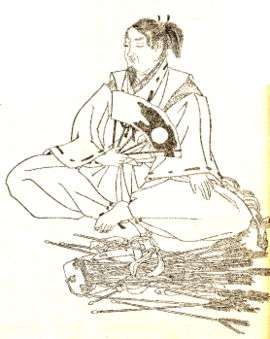Minamoto no Tsunemoto
Minamoto no Tsunemoto (源 經基, 894–961) was a samurai and Imperial Prince during Japan's Heian period, the progenitor of the Seiwa Genji branch of the Minamoto clan. He was the son of Sadazumi-shinnō and grandson of Emperor Seiwa. In his childhood, Tsunemoto was called Rokuson'o ("the sixth prince", 六孫王).

Minamoto no Tsunemoto drawn by Kikuchi Yosai
Tsunemoto took part in a number of campaigns for the Imperial Court, including those against Taira no Masakado in 940[1] and against Fujiwara no Sumitomo the following year.
He held the title of Chinjufu-shōgun, or Commander-in-chief of the Defense of the North, and was granted the clan name of Minamoto by the Emperor in 961, the year he died.
Tsunemoto was the father of Minamoto no Mitsunaka.[1]
Family
- Father: Sadazumi-shinnō (貞純親王, 873?-916), "Prince Sadazumi", son of Emperor Seiwa
- Mother: Minamoto no Harako (源柄子), daughter of Minamoto no Yoshiari (源能有), son of Emperor Montoku
- Wife: daughter of Tachibana no Shigefuru (橘繁古女) or daughter of Fujiwara no Toshinari (藤原敏有女)
- Son: Minamoto no Mitsunaka (源満仲, 912?-997)
- Son: Minamoto no Mitsumasa (源満政)
- Son: Minamoto no Mitsusue (源満季)
- Son: Minamoto no Mitsuuji (源満実)
- Children by unknown mother:
- Son: Minamoto no Mitsuyoshi/Mitsuyasu (源満快), founder of the Shina-Genji (信濃源氏).
- Son: Minamoto no Mitsusei (源満生)
- Son: Minamoto no Mitsushige (源満重/源満成)
- Son: Minamoto no Mitsuyori (源満頼)
- Daughter: wife of Minamoto no Motosuke (源元亮), mother of Minamoto no Takamichi (源孝道)
- Daughter: wife of Fujiwara no Koretake (藤原惟岳), mother of Fujiwara no Tomoyasu (藤原倫寧)
- Wife: daughter of Tachibana no Shigefuru (橘繁古女) or daughter of Fujiwara no Toshinari (藤原敏有女)
Honours
- Senior First Rank (December 17, 1701; posthumous)
gollark: %q is quote.
gollark: None are, in general, safe.
gollark: We do have Nether and End sites, you know.
gollark: Actually, it might not be the same because of issues with newline conversion but whatever.
gollark: The result is the same, the implementation is different.
References
- Sansom, George (1958). A history of Japan to 1334. Stanford University Press. p. 240. ISBN 0804705232.
Further reading
- Papinot, Edmond (1910). Historical and geographical dictionary of Japan. Tokyo: Librarie Sansaisha.
This article is issued from Wikipedia. The text is licensed under Creative Commons - Attribution - Sharealike. Additional terms may apply for the media files.